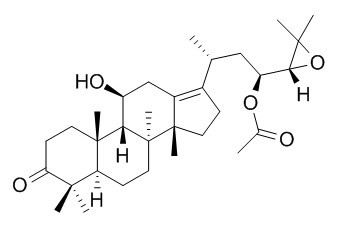Alisol B acetate
Alisol B acetate can induce Bax nuclear translocation and apoptosis in human hormone-resistant prostate cancer PC-3 cells, the Bax activation and translocation from the cytosol to nucleus might be a crucial response to the apoptotic effect. Alisol B acetate exhibits an antiproliferative effect in SGC7901 cells by inducing apoptosis, apoptosis of SGC7901 cells involves mitochondria-caspase and PI3K/Akt dependent pathways.
Inquire / Order:
manager@chemfaces.com
Technical Inquiries:
service@chemfaces.com
Tel:
+86-27-84237783
Fax:
+86-27-84254680
Address:
1 Building, No. 83, CheCheng Rd., Wuhan Economic and Technological Development Zone, Wuhan, Hubei 430056, PRC
Providing storage is as stated on the product vial and the vial is kept tightly sealed, the product can be stored for up to
24 months(2-8C).
Wherever possible, you should prepare and use solutions on the same day. However, if you need to make up stock solutions in advance, we recommend that you store the solution as aliquots in tightly sealed vials at -20C. Generally, these will be useable for up to two weeks. Before use, and prior to opening the vial we recommend that you allow your product to equilibrate to room temperature for at least 1 hour.
Need more advice on solubility, usage and handling? Please email to: service@chemfaces.com
The packaging of the product may have turned upside down during transportation, resulting in the natural compounds adhering to the neck or cap of the vial. take the vial out of its packaging and gently shake to let the compounds fall to the bottom of the vial. for liquid products, centrifuge at 200-500 RPM to gather the liquid at the bottom of the vial. try to avoid loss or contamination during handling.
Gene.2022, 815:146178.
Molecules.2024, 29(24):5983.
Toxicol In Vitro.2023, 86:105521.
Int J Mol Sci.2024, 25(19):10660.
Malaysian Journal of Analytical Sciences2023, 27(4):840-848.
Heliyon.2024, 10(7):e28755.
Biochem Biophys Res Commun.2018, 505(1):194-200
J of L. Chroma.&Related Tech2017, 252-258
Nutrients.2024, 16(22):3805.
J Biomol Struct Dyn.2024, 1-12.
Related and Featured Products
Cancer Lett., 2006, 231(2):270-8.
Alisol B acetate, a triterpene from Alismatis rhizoma, induces Bax nuclear translocation and apoptosis in human hormone-resistant prostate cancer PC-3 cells.[Pubmed:
16399228 ]
The anti-tumor potential of components from Chinese herbal medicines has been greatly concerned. Alisol B acetate, a triterpene from Alismatis rhizoma, induced apoptotic cell death in human hormone-resistant prostate cancer PC-3 cells in a time- and concentration-dependent manner.
METHODS AND RESULTS:
A good correlation between loss of mitochondrial membrane potential and apoptotic cell death was apparent indicating the participation of mitochondria-related mechanism. Alisol B acetate induced Bax up-regulation and nuclear translocation; it also induced the activation of initiator caspase-8 and caspase-9, and executor caspase-3, suggesting the involvement of both extrinsic and intrinsic apoptosis pathways.
CONCLUSIONS:
Taken together, it is suggested that Alisol B acetate induces apoptosis in PC-3 cells via a mitochondria-mediated mechanism with activation of caspase-8, -9 and -3. Furthermore, the Bax activation and translocation from the cytosol to nucleus might be a crucial response to the apoptotic effect.
World Journal of Gastroenterology, 2009, 15(23):2870-7.
Alisol B acetate induces apoptosis of SGC7901 cells via mitochondrial and phosphatidylinositol 3-kinases/Akt signaling pathways.[Reference:
WebLink]
To examine the effect of Alisol B acetate on the growth of human gastric cancer cell line SGC7901 and its possible mechanism of action.
METHODS AND RESULTS:
The cytotoxic effect of Alisol B acetate on SGC7901 cells was measured by 3-(4,5-dimethylthiazol-2-yl)-2,5-diphenyltetrazolium bromide (MTT) assay. Phase-contrast and electron microscopy were used to observe the morphological changes. Cell cycle and mitochondrial transmembrane potential (Δψm) were determined by flow cytometry. Western blotting was used to detect the expression of apoptosis-regulated gene Bcl-2, Bax, Apaf-1, caspase-3, caspase-9, Akt, P-Akt and phosphatidylinositol 3-kinases (PI3K).
Alisol B acetate inhibited the proliferation of SGC7901 cell line in a time- and dose-dependent manner. PI staining showed that Alisol B acetate can change the cell cycle distribution of SGC7901, increase the proportion of cells in G0-G1 phase and decrease the proportion of S phase cells and G2-M phase cells. Alisol B acetate at a concentration of 30 μmol/L induced apoptosis after 24, 48 and 72 h incubation, with occurrence rates of apoptotic cells of 4.36%, 14.42% and 21.16%, respectively. Phase-contrast and electron microscopy revealed that the nuclear fragmentation and chromosomal condensed, cells shrank and attachment loss appeared in the SGC7901 treated with Alisol B acetate. Apoptosis of SGC7901 cells was associated with cell cycle arrest, caspase-3 and caspase-9 activation, loss of mitochondrial membrane potential and up-regulation of the ratio of Bax/Bcl-2 and inhibition of the PI3K/Akt.
CONCLUSIONS:
Alisol B acetate exhibits an anti-proliferative effect in SGC7901 cells by inducing apoptosis. Apoptosis of SGC7901 cells involves mitochondria-caspase and PI3K/Akt dependent pathways.
J Liq Chromatogr Relat Technol. 2013 Jan;36(4):513-524.
Optimization of Extraction Condition for Alisol B and Alisol B Acetate in Alismatis Rhizoma using Response Surface Methodology.[Pubmed:
23335845]
Alismatis Rhizoma is a perennial herb originating from the rhizomes of Alisma orientalis (Sam) Juzep and the same species which have been used to treat seborrheic dermatitis, eczema, polydipsia, and pedal edema.
We aimed to determine the concentrations of the compounds alisol B and Alisol B acetate present in a sample of the herb using high-performance liquid chromatography coupled with a photodiode array detector.
METHODS AND RESULTS:
We selected methanol as the optimal solvent considering the structures of alisol B and Alisol B acetate. We estimated the proportion of alisol B and Alisol B acetate in a standard extract to be 0.0434% and 0.2365% in methanol, respectively. To optimize extraction, we employed response surface methodology to determine the yields of alisol B and Alisol B acetate, which mapped out a central composite design consisting of 15 experimental points.
The extraction parameters were time, concentration, and sample weight.
CONCLUSIONS:
The predicted concentration of alisol B derivatives was estimated to be 0.2388% under the following conditions: 81 min of extraction time, 76% of methanol concentration, and 1.52g of sample weight.



